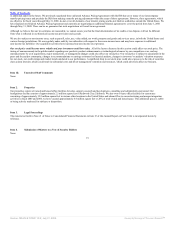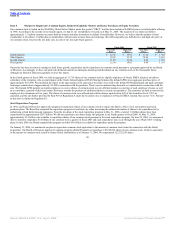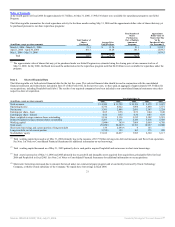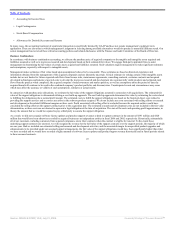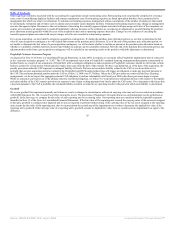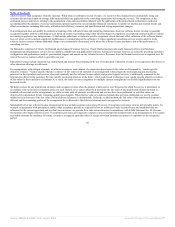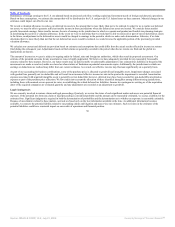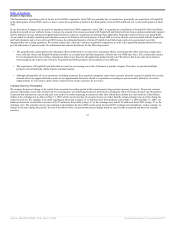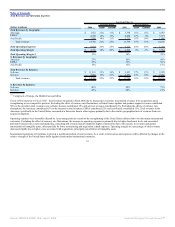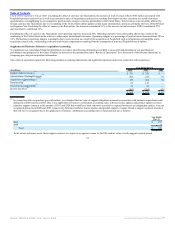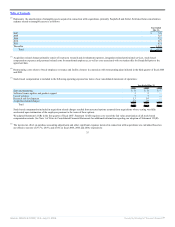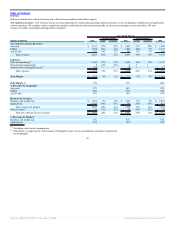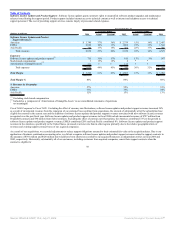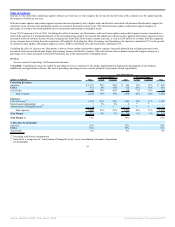Oracle 2005 Annual Report Download - page 32
Download and view the complete annual report
Please find page 32 of the 2005 Oracle annual report below. You can navigate through the pages in the report by either clicking on the pages listed below, or by using the keyword search tool below to find specific information within the annual report.
Table of Contents
We also evaluate arrangements with governmental entities containing “fiscal funding” or “termination for convenience” provisions, when such provisions are
required by law, to determine the probability of possible cancellation. We consider multiple factors, including the history with the customer in similar
transactions, the “essential use” of the software licenses and the planning, budgeting and approval processes undertaken by the governmental entity. If we
determine upon execution of these arrangements that the likelihood of non-acceptance is remote, we then recognize revenue once all of the criteria described
above have been met. If such a determination cannot be made, revenue is recognized upon the earlier of cash receipt or approval of the applicable funding
provision by the governmental entity.
We assess whether fees are fixed or determinable at the time of sale and recognize revenue if all other revenue recognition requirements are met. Our standard
payment terms are net 30; however, terms may vary based on the country in which the agreement is executed. Payments that are due within six months are
generally deemed to be fixed or determinable based on our successful collection history on such arrangements, and thereby satisfy the required criteria for
revenue recognition.
While most of our arrangements include short-term payment terms, we have a standard practice of providing long-term financing to credit worthy customers
through our financing division. Since fiscal 1989, when our financing division was formed, we have established a history of collection, without concessions, on
these receivables with payment terms that generally extend up to five years from the contract date. Provided all other revenue recognition criteria have been met,
we recognize new software license revenues for these arrangements upon delivery, net of any payment discounts from financing transactions. We have generally
sold receivables financed through our financing division on a non-recourse basis to third party financing institutions. We account for the sale of these receivables
as “true sales” as defined in FASB Statement No. 140, Accounting for Transfers and Servicing of Financial Assets and Extinguishments of Liabilities.
Our customers include several of our suppliers and on rare occasion, we have purchased goods or services for our operations from these vendors at or about the
same time that we have licensed our software to these same companies (a “Concurrent Transaction”). Software license agreements that occur within a
three-month time period from the date we have purchased goods or services from that same customer are reviewed for appropriate accounting treatment and
disclosure. When we acquire goods or services from a customer, we negotiate the purchase separately from any software license transaction, at terms we consider
to be at arm’s length, and settle the purchase in cash. We recognize new software license revenue from Concurrent Transactions if all of our revenue recognition
criteria are met and the goods and services acquired are necessary for our current operations.
During the second quarter of fiscal 2006, we recognized new software license revenues of approximately $33 million from a supplier. During the third quarter of
fiscal 2006, we negotiated to acquire goods and services from this supplier and finalized terms of the purchase. The value of the goods and services we will
acquire from this supplier under this agreement will total approximately $20 million over the next five years.
Accounting for Income Taxes
Significant judgment is required in determining our worldwide income tax provision. In the ordinary course of a global business, there are many transactions and
calculations where the ultimate tax outcome is uncertain. Some of these uncertainties arise as a consequence of revenue sharing and cost reimbursement
arrangements among related entities, the process of identifying items of revenue and expense that qualify for preferential tax treatment, and segregation of
foreign and domestic income and expense to avoid double taxation. Although we believe that our estimates are reasonable, the final tax outcome of these matters
could be different from that which is reflected in our historical income tax provisions and accruals. Such differences could have a material effect on our income
tax provision and net income in the period in which such determination is made.
Our effective tax rate includes the impact of certain undistributed foreign earnings for which no U.S. taxes have been provided because such earnings are planned
to be indefinitely reinvested outside the United States.
29
Source: ORACLE CORP, 10-K, July 21, 2006 Powered by Morningstar® Document Research℠


